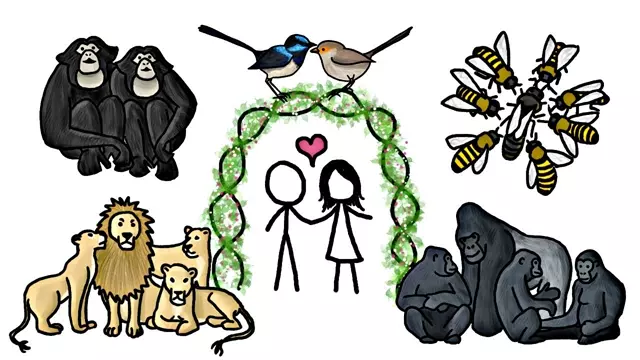2014-02-14
[public] 3.52M views, 70.6K likes, dislikes audio only
Monogamy isn’t that popular in the animal kingdom, and it turns out that even "love birds" are often cheaters.
CREDITS
*********
Created by Henry Reich
Illustration and Animation: Ever Salazar
Production and Writing Team: Alex Reich, Peter Reich, Emily Elert
Music: Nathaniel Schroeder: http://www.soundcloud.com/drschroeder
Thanks to our Subbable supporter ALFREDO STAGG for making MinuteEarth possible!
SUPPORT MINUTEEARTH
**************************
If you like what we do, you can help us!:
- Become our patron: https://patreon.com/MinuteEarth
- Our merch: http://dftba.com/minuteearth
- Our book: https://minuteearth.com/books
- Share this video with your friends and family
- Leave us a comment (we read them!)
OUR LINKS
************
Youtube | https://youtube.com/MinuteEarth
TikTok | https://tiktok.com/@minuteearth
Twitter | https://twitter.com/MinuteEarth
Instagram | https://instagram.com/minute_earth
Facebook | https://facebook.com/Minuteearth
Website | https://minuteearth.com
Apple Podcasts| https://podcasts.apple.com/us/podcast/minuteearth/id649211176
REFERENCES
**************
Barash, D. P., & Lipton, J. E. (2002). The myth of monogamy: Fidelity and infidelity in animals and people. Macmillan.
Brooked, M. G., Rowley, I., Adams, M., & Baverstock, P. R. (1990). Promiscuity: an inbreeding avoidance mechanism in a socially monogamous species?. Behavioral Ecology and Sociobiology, 26(3), 191-199.
Chapais, B. (2013). Monogamy, strongly bonded groups, and the evolution of human social structure. Evolutionary Anthropology: Issues, News, and Reviews, 22(2), 52-65.
de Waal, F. B., & Gavrilets, S. (2013). Monogamy with a purpose. Proceedings of the National Academy of Sciences, 110(38), 15167-15168.
Double, M., & Cockburn, A. (2000). Pre--dawn infidelity: females control extra-pair mating in superb fairy--wrens. Proceedings of the Royal Society of London. Series B: Biological Sciences, 267(1442), 465-470.
Kraaijeveld, K., Carew, P. J., Billing, T., Adcock, G. J., & Mulder, R. A. (2004). Extra‐pair paternity does not result in differential sexual selection in the mutually ornamented black swan (Cygnus atratus). Molecular Ecology, 13(6), 1625-1633.
Ophir, A. G., Phelps, S. M., Sorin, A. B., & Wolff, J. O. (2008). Social but not genetic monogamy is associated with greater breeding success in prairie voles.Animal Behaviour, 75(3), 1143-1154.
Reichard, U. (2002). Monogamy - a Variable Relationship. MaxPlanckResearch Conference Report.
Thusius, K. J., Peterson, K. A., Dunn, P. O., & Whittingham, L. A. (2001). Male mask size is correlated with mating success in the common yellowthroat.Animal Behaviour, 62(3), 435-446.
Wan, D., Chang, P., & Yin, J. (2013). Causes of extra-pair paternity and its inter-specific variation in socially monogamous birds. Acta Ecologica Sinica, 33(3), 158-166.
Webster, M. S., Tarvin, K. A., Tuttle, E. M., & Pruett‐Jones, S. (2007). Promiscuity drives sexual selection in a socially monogamous bird. Evolution,61(9), 2205-2211.
Monogamous primates: http://www-personal.umich.edu/~phyl/anthro/mating.html
http://patreon.com/minuteearth
/youtube/video/bxQdLhOQf5c?t=0
/youtube/video/bxQdLhOQf5c?t=114.04
/youtube/video/bxQdLhOQf5c?t=126.399
/youtube/video/bxQdLhOQf5c?t=153.44
/youtube/channel/UCeiYXex_fwgYDonaTcSIk6w
https://www.patreon.com/minuteearth
/youtube/video/4DF94Wvtekk

